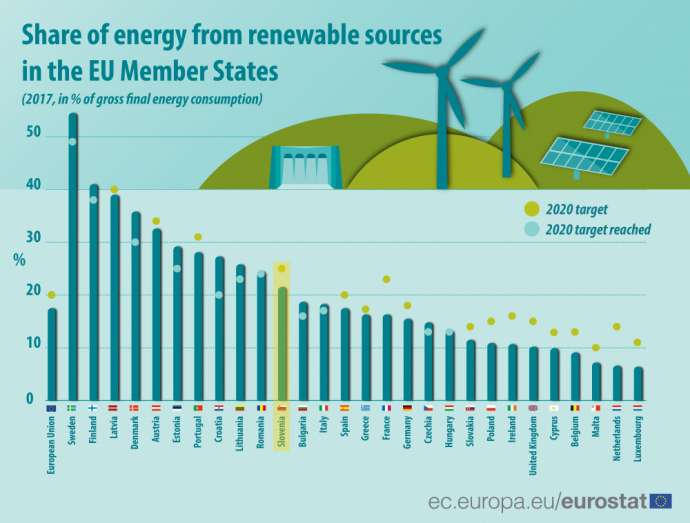STA, 2 July 2019 - The share of electricity from renewable sources in gross end use in Slovenia in 2018 rose by 3.4 percentage points to 21.8% from 2005, the Energy Agency, the national regulator, says in its 2018 report.
This was facilitated by a support scheme which has since 2009 involved more than 2,500 producers with almost 3,860 production facilities running on renewables.
But in line with national goals stemming from the EU's climate and energy package, the share of renewables in gross end use will have to be raised to 25% by 2020.
To achieve this goal, progress will have to be made in transport and in power production, the agency says in the report, which has been sent to the National Assembly.
In transport, Slovenia was by 4.7 percentage points behind the target 10.5% share in 2018, while the gap for electricity output to the 39.3% goal was over 7 points.
Renewables-based power was generated mostly by hydro plants and other plants running on renewables, reaching 34.5% of the country's total power output in 2018, up almost 5 points annually.
The rest of Slovenia's power output came from coal-fired power stations (29%) and the Krško Nuclear Power Plant, the country's only nuclear power station (36.5%).
Domestic electricity production covered almost 85% of domestic electricity consumption, up 1.7 points from 2017.
However, the agency said the output did not reflect the actual potential of the country's electricity production facilities.
It was rather a result of the structure of production facilities, their competitiveness and the emerging electricity market target model, says the report.
For instance, hydro power stations' output depends on water levels, while coal-fired power stations and plants running on liquid and gas fuels strongly depend on daily power consumption as well as on market variables such as the prices of emission coupons, fuel or wholesale.
The agency also says market concentration in the retail market somewhat decreased last year, which shows there is more competition among electricity suppliers.
However, the end price of electricity for an average household edged up 0.3%, while it rose by more than 8% for other users.
While there is still much room to save on electricity bills by changing suppliers, the number of those did so in 2018 dropped by one point to 5.7% over 2017, a second consecutive annual drop.
The Energy Agency is the country's national regulatory authority which directs and supervises electricity and gas energy operators.
Its mission is to act in the interest of all market stakeholders, so it is not financed from the state budget but from network charges.







